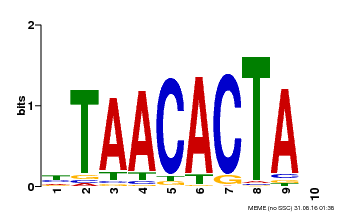 |
PlantRegMap/PlantTFDB v5.0
Plant Transcription
Factor Database
|
| Home TFext BLAST Prediction Download Help About Links PlantRegMap |
Transcription Factor Information
| Basic Information? help Back to Top | |||||||||
|---|---|---|---|---|---|---|---|---|---|
| TF ID | 676718104 | ||||||||
| Organism | |||||||||
| Taxonomic ID | |||||||||
| Taxonomic Lineage |
cellular organisms; Eukaryota; Viridiplantae; Streptophyta; Streptophytina; Embryophyta; Tracheophyta; Euphyllophyta; Spermatophyta; Magnoliophyta; Mesangiospermae; eudicotyledons; Gunneridae; Pentapetalae; rosids; malvids; Brassicales; Brassicaceae; Sisymbrieae; Sisymbrium
|
||||||||
| Family | C2H2 | ||||||||
| Protein Properties | Length: 242aa MW: 25843.7 Da PI: 8.6001 | ||||||||
| Description | C2H2 family protein | ||||||||
| Gene Model |
|
||||||||
| Signature Domain? help Back to Top | |||||||
|---|---|---|---|---|---|---|---|
| No. | Domain | Score | E-value | Start | End | HMM Start | HMM End |
| 1 | zf-C2H2 | 14.1 | 0.00014 | 95 | 117 | 1 | 23 |
EEETTTTEEESSHHHHHHHHHHT CS
zf-C2H2 1 ykCpdCgksFsrksnLkrHirtH 23
ykC+ C+k Fs+ L H +H
676718104 95 YKCSVCDKAFSSYQALGGHKASH 117
9***********99999998887 PP
| |||||||
| 2 | zf-C2H2 | 10.6 | 0.0018 | 150 | 169 | 1 | 20 |
EEETTTTEEESSHHHHHHHH CS
zf-C2H2 1 ykCpdCgksFsrksnLkrHi 20
++C++C+ksF + L H
676718104 150 HVCSICNKSFATGQALGGHK 169
79********9988776665 PP
| |||||||
| Protein Features ? help Back to Top | ||||||
|---|---|---|---|---|---|---|
| Database | Entry ID | E-value | Start | End | InterPro ID | Description |
| SuperFamily | SSF57667 | 3.93E-10 | 94 | 117 | No hit | No description |
| Gene3D | G3DSA:3.30.160.60 | 2.3E-4 | 95 | 117 | IPR013087 | Zinc finger C2H2-type/integrase DNA-binding domain |
| PROSITE profile | PS50157 | 10.637 | 95 | 122 | IPR007087 | Zinc finger, C2H2 |
| Pfam | PF13912 | 6.6E-13 | 95 | 119 | IPR007087 | Zinc finger, C2H2 |
| SMART | SM00355 | 0.0073 | 95 | 117 | IPR015880 | Zinc finger, C2H2-like |
| PROSITE pattern | PS00028 | 0 | 97 | 117 | IPR007087 | Zinc finger, C2H2 |
| SuperFamily | SSF57667 | 3.93E-10 | 145 | 172 | No hit | No description |
| Gene3D | G3DSA:3.30.160.60 | 2.1E-4 | 148 | 173 | IPR013087 | Zinc finger C2H2-type/integrase DNA-binding domain |
| PROSITE profile | PS50157 | 10.325 | 150 | 177 | IPR007087 | Zinc finger, C2H2 |
| Pfam | PF13912 | 2.5E-12 | 150 | 174 | IPR007087 | Zinc finger, C2H2 |
| SMART | SM00355 | 0.073 | 150 | 172 | IPR015880 | Zinc finger, C2H2-like |
| PROSITE pattern | PS00028 | 0 | 152 | 172 | IPR007087 | Zinc finger, C2H2 |
| Gene Ontology ? help Back to Top | ||||||
|---|---|---|---|---|---|---|
| GO Term | GO Category | GO Description | ||||
| GO:0055062 | Biological Process | phosphate ion homeostasis | ||||
| GO:2000280 | Biological Process | regulation of root development | ||||
| GO:0005634 | Cellular Component | nucleus | ||||
| GO:0001047 | Molecular Function | core promoter binding | ||||
| GO:0003700 | Molecular Function | transcription factor activity, sequence-specific DNA binding | ||||
| GO:0046872 | Molecular Function | metal ion binding | ||||
| Sequence ? help Back to Top |
|---|
| Protein Sequence Length: 242 aa Download sequence Send to blast |
MALEALTSPK LASPMPTLFQ DSAVGFQSSK GKRSKRSRSE LDRYNNSLTE DEYIALCLML 60 LARDGDRNRN NRDGDLPSTS SSPLLLPPPT PTPFYKCSVC DKAFSSYQAL GGHKASHRKS 120 SSLTQSSGGD EQSTSSAITV VSQGGSVKSH VCSICNKSFA TGQALGGHKR CHYEGKNGGG 180 SSSVSVSEGL GSTSHVSSGS HHHHRGFDLN IPPIPEFSTV NGDEEVMSPM PTKKLRLDFH 240 SQ |
| Functional Description ? help Back to Top | ||||||
|---|---|---|---|---|---|---|
| Source | Description | |||||
| UniProt | Probable transcription factor that regulates root development and phosphate (Pi) acquisition and homeostasis. Probably acts as a repressor of primary root growth and regulates Pi homeostasis through the control of root architecture. {ECO:0000269|PubMed:17631527}. | |||||
| Binding Motif ? help Back to Top | |||
|---|---|---|---|
| Motif ID | Method | Source | Motif file |
| MP00622 | PBM | Transfer from AT5G04340 | Download |

| |||
| Cis-element ? help Back to Top | |
|---|---|
| Source | Link |
| PlantRegMap | 676718104 |
| Regulation -- Description ? help Back to Top | ||||||
|---|---|---|---|---|---|---|
| Source | Description | |||||
| UniProt | INDUCTION: By cold treatment and during Pi starvation. {ECO:0000269|PubMed:15634197, ECO:0000269|PubMed:17631527}. | |||||
| Regulation -- PlantRegMap ? help Back to Top | ||||||
|---|---|---|---|---|---|---|
| Source | Upstream Regulator | Target Gene | ||||
| PlantRegMap | Retrieve | Retrieve | ||||
| Annotation -- Protein ? help Back to Top | |||||||
|---|---|---|---|---|---|---|---|
| Source | Hit ID | E-value | Description | ||||
| Refseq | XP_013668223.1 | 1e-112 | zinc finger protein ZAT6-like | ||||
| Swissprot | O22533 | 1e-110 | ZAT6_ARATH; Zinc finger protein ZAT6 | ||||
| TrEMBL | A7J146 | 1e-112 | A7J146_BRACI; C2H2 zinc finger protein | ||||
| STRING | XP_010452330.1 | 1e-110 | (Camelina sativa) | ||||
| Orthologous Group ? help Back to Top | |||
|---|---|---|---|
| Lineage | Orthologous Group ID | Taxa Number | Gene Number |
| Malvids | OGEM1211 | 28 | 98 |
| Best hit in Arabidopsis thaliana ? help Back to Top | ||||||
|---|---|---|---|---|---|---|
| Hit ID | E-value | Description | ||||
| AT5G04340.1 | 1e-83 | zinc finger of Arabidopsis thaliana 6 | ||||



